You guys, I’m making the rigatoni.
This is my absolute favorite main dish to make for an easy dinner party. It meets all my requirements: it’s absolutely delicious, it’s simple to make, and it doesn’t require me to labor away in the kitchen and miss my own party. It’s also adaptable: it works great with gluten-free pasta and it doesn’t incorporate cheese.
Plus, it’s perfect for copper.
The recipe
Here it is: Rigatoni with Italian sausage and rapini red sauce, the creation of chef Justin Severino.
 It’s a very simple recipe: tomatoes, Italian sausage, garlic, rapini (or broccolini or broccoli rabe), and rigatoni. That’s it. The proportions in Justin’s recipe are in the traditional Italian style — that is, light on the sausage — but for my American family and guests I double the amount of sausage to a full pound per four-person batch. This makes the sauce more substantial and “sausage-forward” in the American style. For the ingredients, I go high-end on the tomatoes and use organic canned whole San Marzano style, but for the sausage I prefer an everyday grocery store brand that comes in a flat package by the pound. (In my part of the US it’s Johnsonville brand.) I’ve found that strongly spicy sausage doesn’t improve the dish; the flavor comes from the umami of the sausage and regular grocery store “hot” or “sweet” sausage is perfect.
It’s a very simple recipe: tomatoes, Italian sausage, garlic, rapini (or broccolini or broccoli rabe), and rigatoni. That’s it. The proportions in Justin’s recipe are in the traditional Italian style — that is, light on the sausage — but for my American family and guests I double the amount of sausage to a full pound per four-person batch. This makes the sauce more substantial and “sausage-forward” in the American style. For the ingredients, I go high-end on the tomatoes and use organic canned whole San Marzano style, but for the sausage I prefer an everyday grocery store brand that comes in a flat package by the pound. (In my part of the US it’s Johnsonville brand.) I’ve found that strongly spicy sausage doesn’t improve the dish; the flavor comes from the umami of the sausage and regular grocery store “hot” or “sweet” sausage is perfect.
The second adjustment is that I cover and simmer the sauce for at least an hour — preferably two or more — before I add the rapini and proceed to finish the dish. Justin’s recipe doesn’t call for this much simmering but I like to take inspiration from Marcella Hazan and allow plenty of time for the flavor of the tomatoes and sausage to fuse. This long simmer is also what makes this such an entertaining-friendly dish for me. I start the sauce a couple of hours ahead of time and pre-heat a pot of water for the pasta, and so when people are ready to eat I need just 20 minutes to add the greens to the sauce, cook the pasta, and then combine pasta and sauce to finish the dish.
The copper
Another reason why I love making this pasta is that it is an ideal use for a rondeau, my favorite member of the French batterie de cuisine. The recipe calls for simmering the sauce, adding a big pile of greens to soften and cook, and finally adding the cooked pasta and stirring it all together, and I have found the rondeau’s shape to be perfect for this series of cooking tasks.
I usually double the recipe (to serve eight) and use my beloved 30cm (11.8 inches) Jules Gaillard rondeau, which can hold just over 8 quarts (7.8 liters).

But tonight I’m serving nine people and I’m tripling the recipe. I’ve scaled up to this 31cm (12.2 inches) hammered Mora rondeau. It looks almost identical to the Jules piece above but it’s just slightly wider and, more importantly, deeper — it’s 31cm in diameter but as tall as a 32cm rondeau. These few extra centimeters give this Mora piece 10 quarts (almost 9.5 liters) of capacity.

 The second reason I’ve chosen this pan is that it is 3.5mm thick at the rim and I suspect even thicker in the base. The pan body alone, unladen, weighs 6472g (14.5 pounds), slightly heavier than my 32cm modern-era Mauviel rondeau that is 3.7mm at the rim. The Mora et Cie store stamp suggests this piece was sold in Paris between 1924 and 1949; this was the heyday of French pre-war copper cookware when ample supply met peak demand for ultra-thick pieces like this. As to this piece’s make, my research suggests that Mora (later Matfer) sold but did not manufacture cookware; this piece with its pre-WWII stamp could have come from any of several suppliers in Paris (Gaillard, Jacquotot, and Dehillerin sustained their factories until the war) as well as Villedieu. (I believe Matfer’s post-WWII copper came primarily and possibly exclusively from Mauviel.)
The second reason I’ve chosen this pan is that it is 3.5mm thick at the rim and I suspect even thicker in the base. The pan body alone, unladen, weighs 6472g (14.5 pounds), slightly heavier than my 32cm modern-era Mauviel rondeau that is 3.7mm at the rim. The Mora et Cie store stamp suggests this piece was sold in Paris between 1924 and 1949; this was the heyday of French pre-war copper cookware when ample supply met peak demand for ultra-thick pieces like this. As to this piece’s make, my research suggests that Mora (later Matfer) sold but did not manufacture cookware; this piece with its pre-WWII stamp could have come from any of several suppliers in Paris (Gaillard, Jacquotot, and Dehillerin sustained their factories until the war) as well as Villedieu. (I believe Matfer’s post-WWII copper came primarily and possibly exclusively from Mauviel.)
I want heavy copper for this recipe because it’s a thick sauce and I have a tricky stovetop. As I explain above, I like to set this sauce up for a long simmer — two hours at least — and I want to keep the temperature steady while I’m out of the kitchen doing other things. This sauce is thick and chunky and its texture makes it prone to scorching if the temperature is too high. If the sauce were thinner, the liquids could establish flowing convection currents to circulate and release heat, but the solids in a thick sauce like this one can “pile up” at the floor of the pan, trapping pockets of moisture that flash-steam and overheat the solids around them.
My elderly Thermador gas stovetop is a finicky one: the so-called “extra low simmer” function turns the low gas flame on and off at intervals. This means that heat does not flow into the pan at a consistent rate and I sometimes have a hard time achieving a steady simmer. The 3.5mm thickness of copper in this rondeau addresses that: the copper both spreads as well as retains heat, which helps even out the flow from the flame into the food and minimizes the temperature fluctuation as the flame cycles on and off.
The third reason is psychological. I am convinced that heavy copper helps prevent me from screwing up. A better cook than I could make this dish in any regular old pan on a wonky stove like mine, but I’m pretty inexperienced. Using this pan makes me feel like my sauce is in good hands and that’s what gives me the confidence to step away from the stovetop and take care of all the other things that go along with entertaining.
The prep
 Tonight I’m tripling the recipe. That should be enough for twelve, but I have nine hungry people coming (including myself) who love this dish and will eat it all up. So I have three cans of tomatoes, three flats of sausage, three pounds of pasta, three bunches of broccolini, and several garlic cloves.
Tonight I’m tripling the recipe. That should be enough for twelve, but I have nine hungry people coming (including myself) who love this dish and will eat it all up. So I have three cans of tomatoes, three flats of sausage, three pounds of pasta, three bunches of broccolini, and several garlic cloves.
Initial prep is straightforward. First step is to crush the tomatoes. I buy canned whole San Marzano tomatoes and I pour them into a big bowl and squeeze them with my fingers to break the big pieces into smaller chunks and shreds. (I have to wear an apron for this because no matter how careful I am, I always manage to squirt myself with tomato juice.) The texture doesn’t need to be uniform — the long simmer will break them down almost completely.
To prep the broccolini, I use kitchen shears to snip the stalks of the tender florets and then rinse them. I set them in a bowl in the fridge to stay crisp while the sauce simmers.
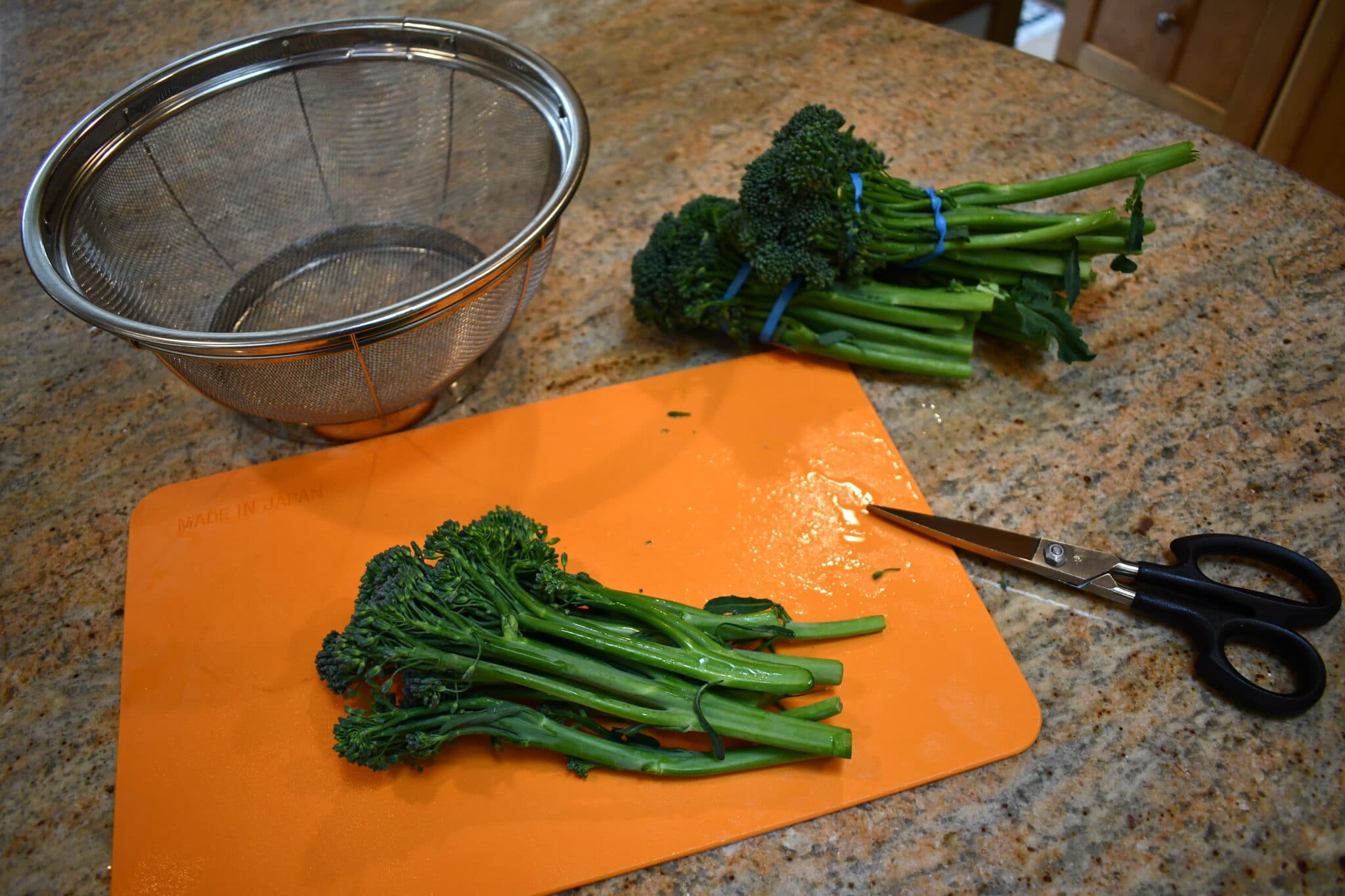
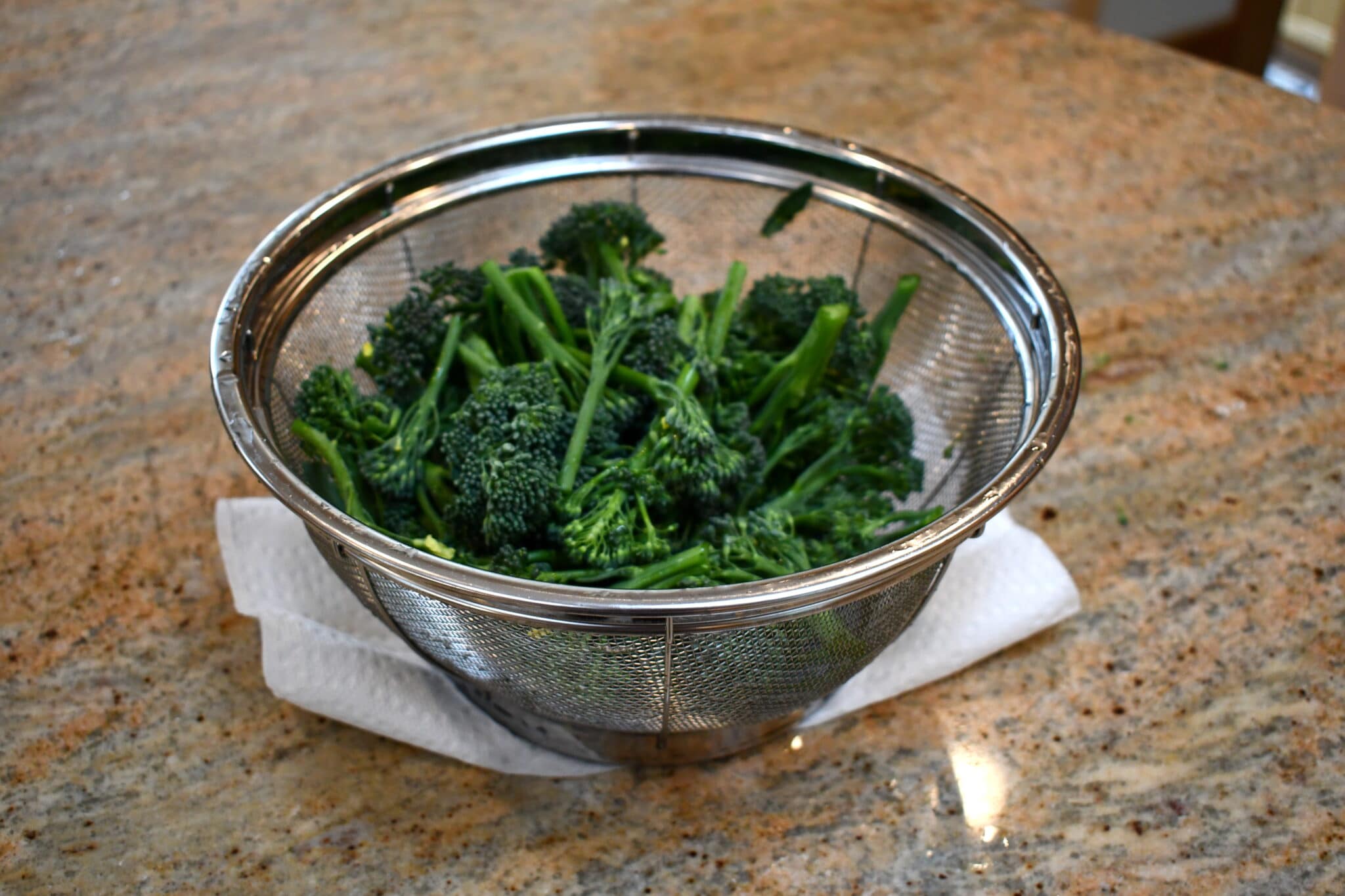
Here is everything ready to start the sauce: tomatoes crushed, garlic pressed, sausage packages ready to be opened.

Cooking
The first cooking step is to sauté the sausage in some olive oil. When it’s lightly browned I clear a space in the middle and cook the garlic for about a minute. Then I stir the garlic into the sausage, add the tomatoes, stir again, and set the sauce up for the simmer. Here’s how that looks, from raw sausage to browned, and then with the tomatoes added.



The sauce is now ready for its long simmer. I shift it to the back burner, bring it to a lively simmer, and then set the temperature way down. The photos below show the sauce early on with gentle bubbles breaking through and then an hour or so into it. You can see how the sauce has relaxed as the tomatoes have broken down.


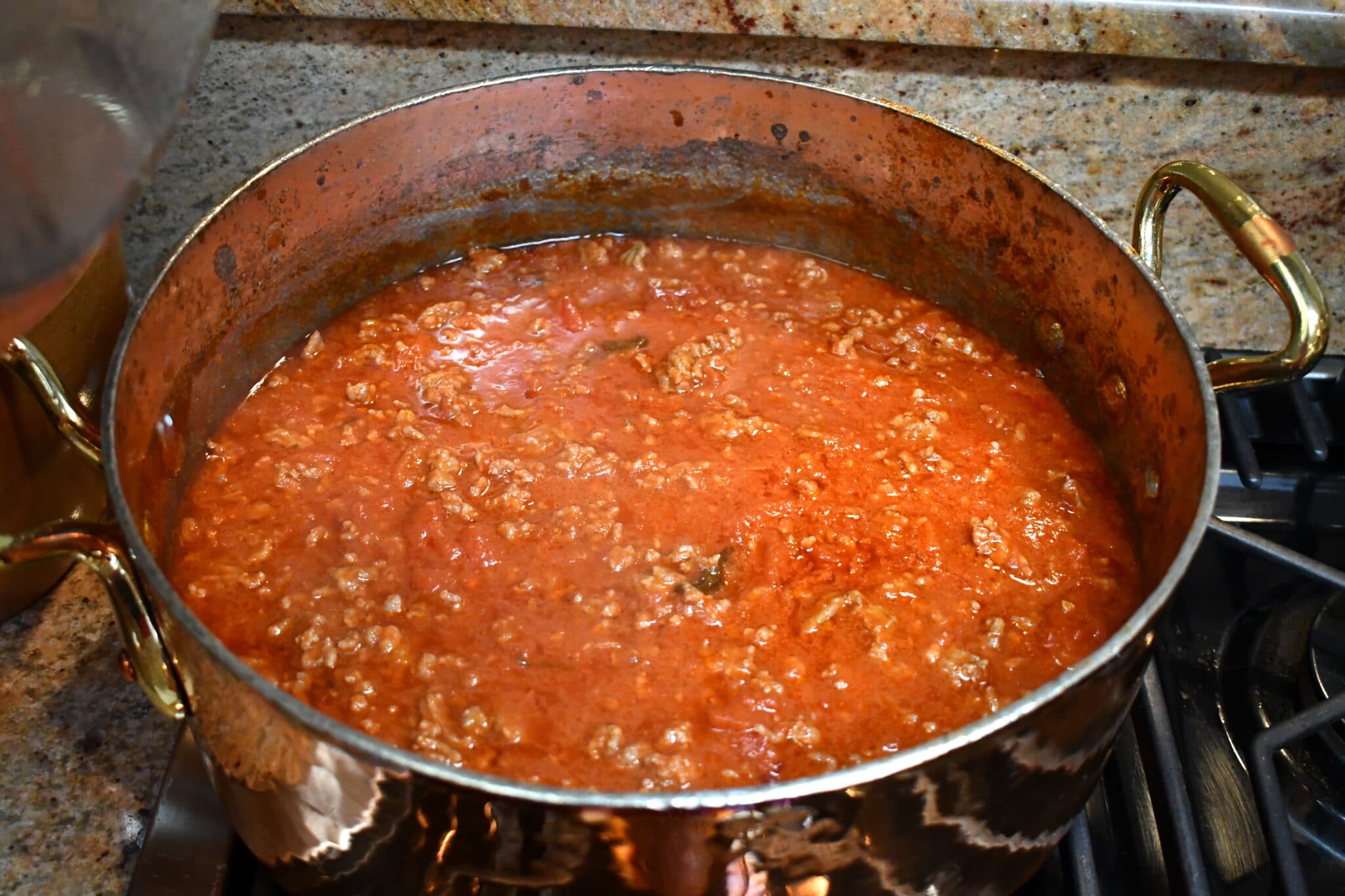
 With the sauce set up to simmer, I can hit pause, so to speak, and move on to other tasks. The next thing I will need to do — the last stage in cooking the sauce — is to add the greens so they can soften, but I can hold off on that until just before serving time. I plan for twenty minutes to add the greens to the sauce, cook the pasta, and combine pasta and sauce to finish the dish.
With the sauce set up to simmer, I can hit pause, so to speak, and move on to other tasks. The next thing I will need to do — the last stage in cooking the sauce — is to add the greens so they can soften, but I can hold off on that until just before serving time. I plan for twenty minutes to add the greens to the sauce, cook the pasta, and combine pasta and sauce to finish the dish.
In the meantime, I set up a pot of water to pre-heat for the pasta. With pasta water just under the boil, I can get the pasta cooking within a couple of minutes. I’m using another vintage piece here — a lovely hammered 28cm aluminum stockpot. The layout of my house means that guests often walk straight through the kitchen as they come into the house and I like how this pretty stockpot winks at them as they go by, promising good things to come.
Dinner time
When people are ready to eat, I shift into active mode. I increase the flame under the stockpot to bring the pasta water to a rolling boil. Then I add the greens to the sauce so they can start cooking. The amount of time needed for this depends on the type of green (robust rapini needs more time than tender broccolini) and the diameter of the stalks (thicker stalks and stems need more time to soften). In this case, I have nice tender young broccolini so they will need just about 10 minutes.
With the greens cooking along in the sauce, I add pasta to the stockpot. Once the pasta is just barely al dente, I drain it, catching a cup or so of starchy water. I bring the rondeau to a front burner, put it on low flame, and add the pasta. I stir it all together, splashing in a little starchy pasta water to loosen the sauce and help it adhere to the pasta. The rigatoni continues to cook for these few more minutes, absorbing sauce and flavor while I call my guests to the table.
What I love about this dish is that it makes me feel so good to serve it. It’s easy to shop for, easy to prepare, flexible in its timing, and delivers a huge amount of flavor. I don’t even add salt (or sugar, as the recipe offers) because my guests love it just as it is. I am really grateful to Justin Severino for sharing it with us all, as it has given me an easy dinner party offering that people now ask me to make!
Readers, have you tried this recipe? I’m always looking for easy entertaining recipes like this one — are there others you’d like to showcase for the rest of us to try?




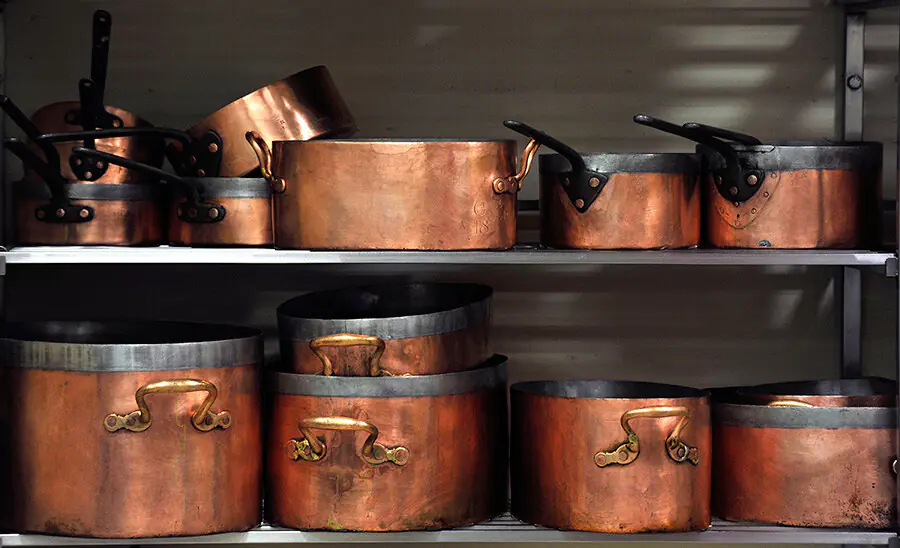
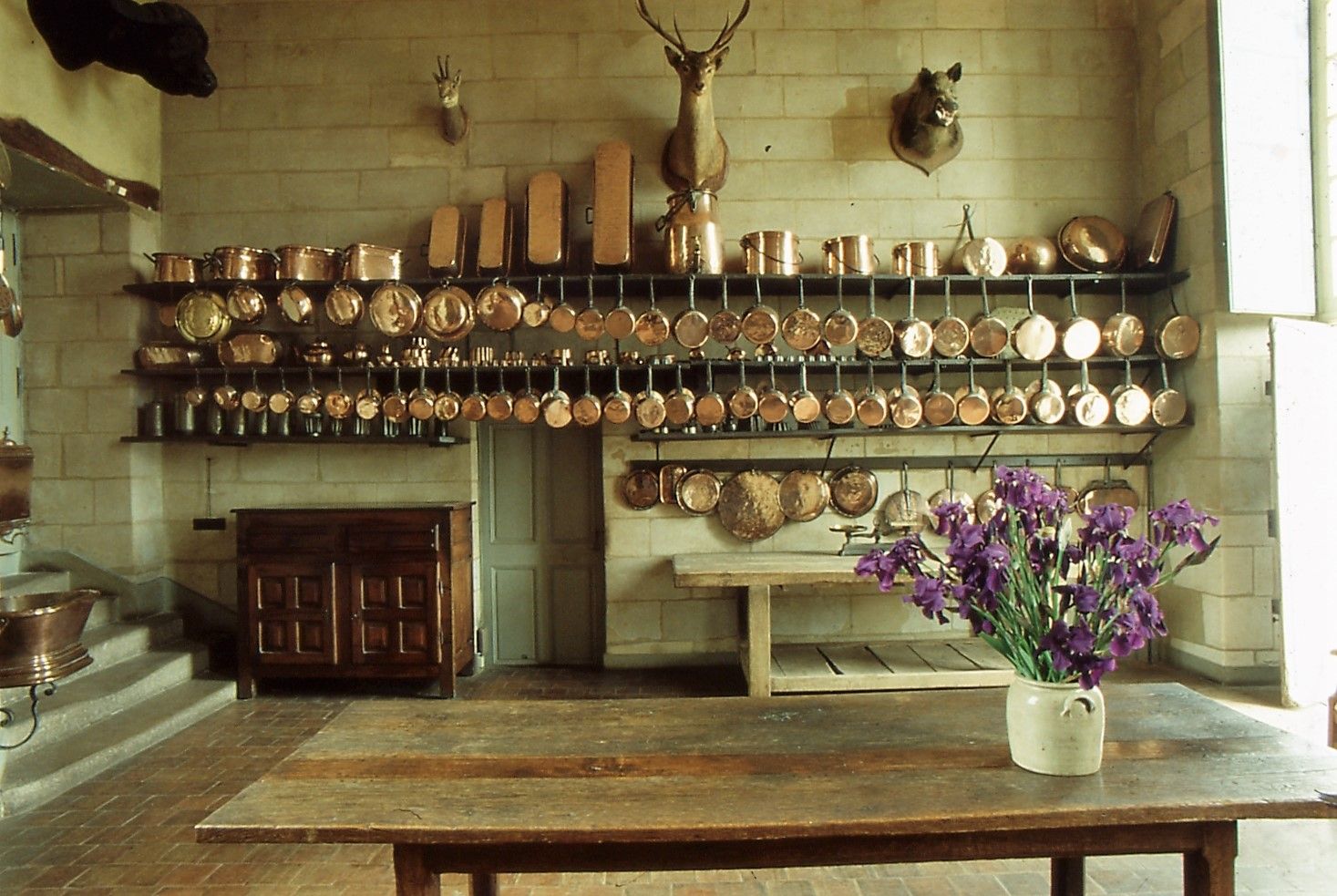
That looks so delicious and the vintage copper pans are simply perfect for dishes like this. Most often I use my copper rondeaus for such dishes as braised beef short ribs, lamb shanks, veal osso buco, beef daube and veal stew. I don’t do much Italian style cooking but I have a Italian-American friend who loves to cook and so get to enjoy many Italian style dishes.
Thank you Stephen! It’s my favorite dinner for company because it makes me feel like a super chef!
Ah, bon gusto, abbondanza! I’ll bet the house smelled wonderful, too. Next time, please share your preferred wash-up technique for that big, beautiful working copper! 😉
Heya Val! Grazie mille!
It looks great, but if animal living and slaughtering conditions are important to you, the place to be cheap is not with your proteins a la Johnsonville.
Not trying to be a downer, always love the great copper posts. But with mass produced meat and factory farming, it’s a large company and unlike smaller farms, for those at the top money will always come over the animals. That’s why it’s cheap for the consumer, it’s the animals who pay the price for it.
No disrespect, but in this case you splurged on the tomatoes and didn’t want to spend more than a couple bucks on Mr. Piggy’s actual flesh, and you doubled the quantity of the pork in the recipe, so in my opinion that’s backwards.
Just trying to do some good here, I think if we have the financial means to do so, we ought to support our local farms, even though it costs more. Besides the fact it’s keeping the farms going and the product is better quality, it’s better for the animals who suffer less and have better living conditions. I’ll get off my soapbox now, have I mentioned no disrespect? Great pics and great pans,
Joe
Joe, that is an absolutely fair critique. For what it’s worth, my preference for the Johnsonville brand is based on the flavor of it, not the price consideration. I’d be happy to consider alternatives but the small-farm pork products I see at my local marketplaces are specialized with specific flavors or spiciness that in my assessment won’t suit this dish. But your point is well taken. I will keep an eye out for small-farm producers that offer conventional pork products (and of course this dish could be attempted with a savory plant-based protein as well). Thanks for your respectful and constructive comment.
That looks delicious!!
Another great post!
I love my Rondeau. I bought another one that I’m awaiting shipment on. It’s the perfect stove to oven pan. I certainly having been reaching for it more and more lately.
Great Dish
You know it’s actually a great tuesday night dish too, except you don’t cook it down for 2 hours.
And personally, I’m gonna cover mine with parmesan.
I love that you included how the copper actually allows you to cook with even temps on a stove that turns on and off. That really makes a difference.